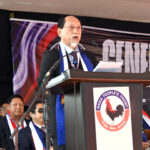As human populations and demand for space continue to grow, people and wildlife are increasingly interacting and competing for resources, which can lead to increased human-wildlife conflict (HWC), like the ones that happened in Marepkong Ward, Mokokchung recently.
HWC occurs when the needs and behavior of wildlife impact negatively on humans or when humans negatively affect the needs of wildlife. These conflicts may result when wildlife damage crops, or threaten, kill or injure people and domestic animals. The number of these conflicts has increased in many regions in recent decades as a result of human population growth and land use change.
It is said that one of the major causes of HWC is increasing human population adjacent to wildlife habitats. As the human population increases and the demand for resources grows, the frequency and intensity of such conflicts increases. This can be manifested by increasing encroachment to wildlife habitats. As a result, the populations of those species which are unable to adapt to altered habitats may invade the marginal habitats or decline in number. HWC undermines human welfare, poses a threat to human health and safety, and has economic, cultural and social costs. Because HWC is a reciprocal process, humans and animals are both negatively affected by the conflict, and it is one of the most complex and urgent issues facing wildlife management and conservation.
Retaliation against the wildlife blamed often ensues, leading to conflict about what should be done to remedy the situation. Although this is not a new scenario, as people and wildlife have coexisted for millennia, it is one that is becoming much more frequent, serious and widespread. In fact, it is now accepted as a global concern for conservation and development alike.
Much research and collective experience across the world has shown that each case of conflict is different from the next, making it difficult to devise easily transferable solutions. Therefore, interdisciplinary approaches are essential to understanding what a given conflict is about, knowing what is needed for mitigation of a given conflict, and ensuring access to the necessary skills and resources. However, in places like Mokokchung, such access to skills and resources are not readily available. It is, therefore, imperative on the part of both the authorities concerned and the stakeholders to collaborate and cooperate in order to mitigate the HWC before it is too late, without waiting for the necessary skills and resources. That invariably begs the question of who should take the lead or initiative. HWC often go unreported in places like Mokokchung, indicating that there is a lack of awareness. Perhaps, we can start with intensive awareness campaigns before we seek high-end interventions. We will have to start somewhere and educating the masses about human-wildlife coexistence can be a starter.
Of course, human-wildlife coexistence is as complex and context-specific as conflict. At the most basic level, the goal of coexistence requires that at some level and in some form, humans must choose to share landscapes and natural resources with wildlife in sustainable ways. Otherwise, extinction of wildlife from our landscapes and having to deal with the consequences brought about by the loss of ecological balance could very well become our reality sooner than later.


